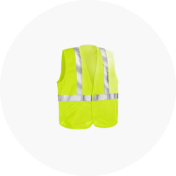When it comes to workplace safety, visibility is key. High Visibility Safety Vests provide employees with the visibility they need to be safe while working in hazardous environments. These vests are an essential piece of personal protective equipment (PPE) that helps reduce the risk of accidents and injuries by ensuring that workers are visible from a distance.
What Are High Visibility Safety Vests?
High Visibility Safety Vests are garments designed to enhance the wearer's visibility, especially in environments where poor lighting, fast-moving vehicles, or machinery pose a risk. These vests are typically made from fluorescent, durable fabric and feature reflective tape or strips for enhanced visibility, even in low-light conditions.
Why Are High Visibility Safety Vests Important?
-
Increased Visibility
High Visibility Safety Vests use bright fluorescent colors like yellow, orange, and lime, which stand out in various environments, making workers more noticeable. They also feature reflective strips that allow workers to be seen in low-light or nighttime conditions. -
Reducing Accidents and Injuries
Workers in environments like roadways, construction sites, and factories are at risk of being struck by moving vehicles or machinery. Wearing a high visibility vest helps mitigate this risk by ensuring the worker can be seen from a distance, giving others more time to react. -
Compliance with Safety Standards
High Visibility Safety Vests are an essential part of many workplace safety programs. They must meet specific standards, including those set by OSHA and ANSI, to ensure that the visibility requirements are met for various work environments.
What Are OSHA Requirements for High Visibility Safety Vests?
The Occupational Safety and Health Administration (OSHA) mandates that employers provide high visibility garments for workers exposed to hazards from moving vehicles. These garments must meet the ANSI/ISEA 107-2015 standards, which ensure visibility from at least 360 degrees and from a minimum distance of 1,280 feet in normal daylight.
Different ANSI Classifications for Safety Vests
ANSI safety vests are categorized into three classes based on the level of visibility they provide. Each class is designed for specific work environments and risk levels:
-
Class 1 Vests
- Visibility Level: Basic visibility for workers in low-risk environments.
- Ideal for: Workers in areas with minimal vehicle traffic, such as parking lots or in warehouses.
- Uses: Parking attendants, warehouse workers, or pedestrian traffic.
-
Class 2 Vests
- Visibility Level: Moderate visibility for workers exposed to vehicles or machinery.
- Ideal for: Workers on roadways, utility workers, or those working in or near traffic.
- Uses: Construction workers, surveyors, or roadside workers.
-
Class 3 Vests
- Visibility Level: High visibility for workers in high-risk environments, especially those exposed to high-speed traffic.
- Ideal for: Emergency responders, highway construction workers, or those working on roadways.
- Uses: Emergency responders, highway workers, or airport personnel.
Choosing the Right Safety Vest for Your Job
The type of ANSI class safety vest you need depends on the specific risks associated with your work environment. Here’s a quick guide:
- Class 1: Ideal for low-risk environments with minimal vehicle traffic, like parking attendants or warehouse workers.
- Class 2: Suitable for moderate-risk environments, including construction sites, utility work, and those working on roadsides.
- Class 3: Designed for high-risk, high-speed environments, such as emergency responders or highway construction workers.
Who Needs High Visibility Safety Vests?
High Visibility Safety Vests are used by a wide range of professionals, including:
- Construction Workers
- Highway Workers
- Roadside Workers
- Warehouse Workers
- Utility Workers
- Emergency Responders
- Cyclists, Hikers, and Motorcyclists
- Railway Workers
- Parking Attendants
- Surveyors
- Airport Personnel
- Military Personnel
Maintaining and Inspecting Your Safety Vest
To ensure that your high visibility vest continues to provide maximum protection, it’s important to:
- Inspect Regularly: Check for any wear and tear, such as fraying or reflective tape deterioration.
- Proper Maintenance: Keep the vest clean and store it in a cool, dry place away from direct sunlight.
- Replace When Necessary: Replace the vest if it becomes damaged or fails to meet visibility standards.
Conclusion
High Visibility Safety Vests are crucial for ensuring the safety of workers in environments where visibility is compromised, such as construction sites, roadways, and industrial settings. Choosing the right vest based on your job’s specific hazards, maintaining it properly, and ensuring it meets safety standards will help protect you and your coworkers from accidents and injuries.
Stay safe and seen—make sure you are wearing the appropriate high visibility safety vest for your work environment! If you're uncertain about which vest is right for your needs, consult with a safety professional or your employer.
For more information on safety vests and PPE solutions, contact us today!










